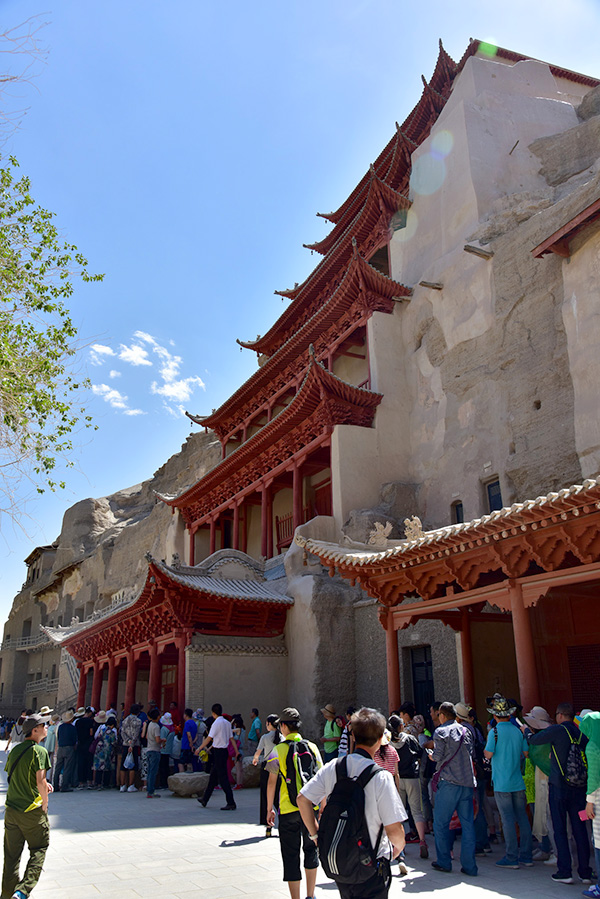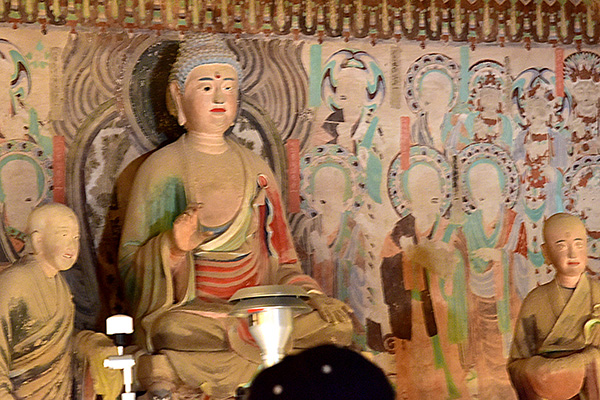A few weeks ago, I wrote a blog about the Indiana Jones aspects of riding a motorcycle across China, and in that blog, I told you about the Roman Legions that had settled in Liqian two thousand years ago. I mentioned that there were other Indiana Jones experiences to be had in China and I said I would write about them. It’s time to keep that promise. This blog is about the abandoned Mo Gao Buddhist grottos in the Gobi Desert. It’s an excerpt from Riding China, and if you want to get the whole story, well, hey, buy the book!
Dun Huang
The day was to be a short one for riding (only a hundred kilometers), but it would be rich with sightseeing in and around Dun Huang. It started with a short ride to Dun Huang’s vendor stalls with all kinds of brightly-colored trinkets, lots of Chinese tourists, and around it all, huge sand dunes. We had arrived at what might possibly be the least known and most inaccessible tourist attraction in the world: The Gobi Desert, up close and personal.

The signs pointed to the Lake of the Crescent Moon (and if that doesn’t sound like an Indiana Jones movie title, I don’t know what does). It was a small bright green crescent lake surrounded by the Gobi’s massive pale white dunes. The city planners in Dun Huang were making good use of it as a tourist attraction. It was amazing. The lake was a bright green arc of still water perhaps 300 meters long, forming a natural arc in the dunes, surrounded by bright green vegetation. I can only imagine how a camel caravan would have felt coming upon this place a thousand or more years ago, slowly drifting through the oven that is the Gobi, long before Dun Huang built its five-star tourist hotels. They must have viewed it as a miracle. A true oasis in the desert. It seemed to be a miracle to me and I had it easy; I had ridden here on my RX3.
Gobi Camel Riding
What really interested me were the camels. I was still feeling smug about seeing camels in the desert the day before, and I had wondered what it would be like to ride one. This was to be my day. There was a large camel riding operation set up specifically for tourists, and I realized I might never have an opportunity like this again. I needed to ride a camel. Yep, I became Joe Tourist, and I’m glad I did. It was fun. The camels took us to the top of one of the dunes, and I loved every minute of it. I’ve heard camels described as ships of the desert, and I realized as I rode along on mine that it was an appropriate description. A camel kind of rocks back and forth as it walks, the same way a ship does as it sails the ocean. The sand dunes, devoid of any vegetation, could be rolling waves. It’s all very calming. The camel behind mine came closer, and closer, and closer until its face was literally right alongside me. Its nose was just an inch from my arm. I could feel its warm dry breath on my arm and my face. It sounds a bit on the strange side, I know, but it was all somehow very soothing, riding along in the hot dry air, gently rocking left and right, with a camel breathing in my ear.



We spent the entire morning riding camels, taking photos, and being tourists. As much as I like riding my motorcycle, it was good to be off it for a day. We were all feeling great, even though it as incredibly hot. But it was dry, and that made it bearable.

The Mo Gao Grottos
That afternoon, we parked the bikes and rode in air-conditioned buses to the Mo Gao Buddhist grottos. This was more Indiana Jones stuff. It’s another incredible story, and it is one I had never heard until this trip. Listen to this: Ancient Buddhists created a massive temple complex in the grottos along a riverbed canyon wall in a location called Mo Gao. It’s in the desert outside of what is now Dun Huang. It was a thriving Buddhist center a thousand years ago, and then the people living there left. No one really knows why. Time and history forgot about the place. It was only recently rediscovered, and a few years after that, it opened to the public. The place was stunning. I can see it possibly being named the 9th Wonder of the Ancient World, just as Xi’an’s Terra Cotta soldiers (which I’ll describe in a later chapter) became the 8th Wonder of the Ancient World. It’s that wondrous.
The Mo Gao caves consisted of many smaller grottos that were apartments for ancient monks, and larger ones that held majestic statues and ornate decorations. I can only imagine what it must of have been like for the archeologists who uncovered these things. Today, it is all closely managed and Chinese police were there to enforce a photography prohibition.



There are two reasons for a photography prohibition in these kinds of places. The first is that flash photography could degrade the statues and artwork. A natural light photo (one shot without flash) would prevent that kind of degradation, but most people wouldn’t understand the distinction and a “natural light only” photo policy would be too hard to enforce. The other reason is that the owner of the place (I assume it would be the Chinese government) probably wants to sell its photos. Allowing people to grab their own pictures would interfere.
The bottom line to all of the above is that the no photography policy only slowed me a little. I waited until somebody else took a photo and the picture police started yelling at them, and then I would discreetly do my natural light thing. I got some good shots, too.
Let me go tangential here for a moment and tell you a quick story about Joe Gresh. He is a great guy to travel with and I’d go anywhere with him. We both have a twisted, extremely wry, and very corny sense of humor. He cringed every time I said something I thought was clever, and I did the same with him. I enjoyed being with him on this trip immensely. The guy just has a way with words, which is readily apparent in his columns for Motorcyclist magazine. Anyway, as we walked along one of the landscaped Mo Gao pathways, I noticed a ground-mounted speaker that was in a plastic case designed to look like one of the naturally-occurring rocks. It blended in well with other real rocks along the path. I pointed to it and said to Joe, “Look at that…even a thousand years ago, these Buddhist monks had electric speakers…”
Gresh, without missing a beat, responded with, “Yeah, they loved their grotto blasters…”
I slept well that night in our unusually upscale hotel. I probably had dreams along the lines of an Indiana Jones movie plot, but I didn’t remember any of them. I was tired when I called it a night and I felt refreshed the next morning. This was the trip of a lifetime, and I was enjoying the hell out of it.
So there you have it. The Mo Gao Grottos. Lost in time nearly a thousand years, only to be discovered again a few years ago. And we were there. Indiana Jones? You bet! And if you want to read the earlier Indy in China blog about the Romans, it’s right here!
Don’t miss anything! Sign up right here to see our blogs as they are published!

It’s a good thing you wrote the book. Memories are already fading.
Who are you, again?
you guys actually read each others blogs? LMAO! anyway, this is cool. although the chinese government has done much to destroy Tibet Buddhism . and here they are , communists , trying to make a buck off a Buddhist historical sight. i am glad you guys went and were able to use the trip to enlighten us armchair types. otherwise i would have never known of this place. i have no desire to visit china under its present government. but as i said, this is cool.